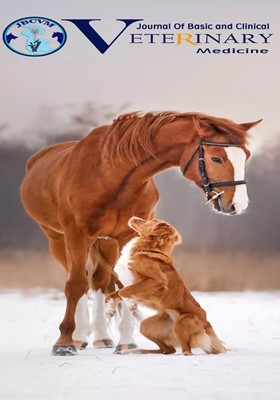Zinc deficiency in sheep flock in Kerman suburb-Iran: a clinicopathologic study of four cases with a review of literature
Subject Areas : Large Animal Internal Medicine
Omid Mohammadpour
1
![]() ,
shahrzad Azizi
2
,
shahrzad Azizi
2
![]() ,
Amir Amniattalab
3
,
Amir Amniattalab
3
![]() ,
Zanyar Pirkani
4
,
Zanyar Pirkani
4
1 - Department of Clinical Sciences, Faculty of Veterinary Medicine, Shahid Bahonar University of Kerman, Kerman, Iran
2 - Department of Pathobiology, Faculty of Veterinary Medicine, Shahid Bahonar University of Kerman, Kerman, Iran
3 - Department of Pathobiology, Faculty of Veterinary Medicine, Urmia Branch ,Islamic Azad University, Urmia, Iran
4 - Department of Clinical Sciences, Faculty of Veterinary Medicine, University of Tehran, Tehran, Iran
Keywords: Sheep, Zinc deficiency, Kerman, Parakeratosis,
Abstract :
Primary zinc deficiency is not common in ruminants, but its occurrence has been documented. This study was conducted on a flock of 45 Kermani sheep during February 2022 to June 2022. The signs of alopecia, pityriasis, infertility, growth retardation, weakness, anorexia, itching, pneumonia, conjunctivitis, and increased risk of infection, which was suspected of zinc deficiency, were observed in 4 sheep. The heart rate, respiration rate, body temperature, and blood indices including PCV, total and differential white blood cell count, and red blood cell count were measured. Hematology results indicated a significant increase in white blood cells in affected sheep. The achieved biopsied cutaneous tissues of the sheep with skin lesions, were stained by Hematoxylin and Eosin method. Pathologically, the parakeratosis was observed in cornified squamous epithelium and therefore zinc deficiency was confirmed. The treatment strategy included oral zinc sulfate tablets with a dose of 250 mg per day for 4 weeks and the use of mineral bricks to continue the treatment process. After 10 weeks, signs of recovery appeared.
[1] Ahmed KD, Alrawi ST, Omar AA. Comparative study of local sheep reared in different environmental and feeding conditions on some hematological and biochemical traits. Biochem. Cell. Arch. 2020. 20(1):87-89.
[2] Ali A, Derar DR, Alhassun TM, Almundarij TI. Effect of zinc, selenium, and vitamin E administration on semen quality and fertility of male dromedary camels with impotentia generandi. Biological Trace Element Research. 2021 ;199(4):1370-6.
[3] Bribiesca JE, Casas RL, Monterrosa RG, Pérez AR. Supplementing selenium and zinc nanoparticles in ruminants for improving their bioavailability meat. In Nutrient Delivery. 2017. 1:713-747.
[4] Chafik A, Essamadi A, Çelik SY, Mavi A. Purification and biochemical characterization of a novel copper, zinc superoxide dismutase from liver of camel (Camelus dromedarius): An antioxidant enzyme with unique properties. Bioorganic Chemistry. 2019. 1;86:428-36.
[5] Ghazanfari MJ, Karkhah S, Zeydi AE. Zinc supplementation in mechanically ventilated ICU patients: A promising preventive modality for ventilator-associated pneumonia. Clinical Nutrition Open Science. 2021. 1;40:38-9.
[6] Gray NA, Dhana A, Stein DJ, Khumalo NP. Zinc and atopic dermatitis: a systematic review and meta‐analysis. Journal of the European Academy of Dermatology and Venereology. 2019; 33(6):1042-50.
[7] Karabay EA, Cerman AA. Serum zinc levels in seborrheic dermatitis: a case-control study. Turkish Journal of Medical Sciences. 2019; 49(5):1503-8.
[8] Nasr MY, Bakir NM, Beder NA, Mayal RM. Studies on nutritional deficiency in cows in El-Behera province. Damanhour Journal of Veterinary Sciences. 2019 11;2(2):5-8.
[9] National Research Council (US). Committee on Nutrient Requirements of Small Ruminants, National Research Council, Committee on the Nutrient Requirements of Small Ruminants, Board on Agriculture, Division on Earth, Life Studies. Nutrient requirements of small ruminants: sheep, goats, cervids, and new world camelids. 2007; 5:12-18
[10] Ogawa Y, Kinoshita M, Shimada S, Kawamura T. Zinc and skin disorders. Nutrients. 2018; 11;10(2):199.
[11] Prasad AS. Discovery of human zinc deficiency: 50 years later. Journal of Trace Elements in Medicine and Biology. 2012; 1;26(2-3):66-9.
[12] Radford RJ, Lippard SJ. Chelators for investigating zinc metalloneurochemistry. Current opinion in chemical biology. 2013; 1;17(2):129-36.
[13] Shayestehfar MR, Shafiei N ,Shirani H, Rezayi A, Dianati MR. Distribution of arsenic and selenium elements in the soils around the Sarcheshme copper mine in Kerman., Water and Soil Journal (Agricultural Sciences and Industries). 2012; 26(3): 533-544.
[14] Stewart WC, Scasta JD, Taylor JB, Murphy TW, Julian AA. Invited Review: Mineral nutrition considerations for extensive sheep production systems. Applied Animal Science. 2021 1;37(3):256-72.
[15] Touat-Hamici Z, Legrain Y, Bulteau AL, Chavatte L. Selective up-regulation of human selenoproteins in response to oxidative stress. Journal of Biological Chemistry. 2014 23;289(21):14750-61.
[16] Wright CL, Spears JW, Webb Jr KE. Uptake of zinc from zinc sulfate and zinc proteinate by ovine ruminal and omasal epithelia. Journal of animal science. 2008; 1;86(6):1357-63.


